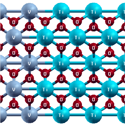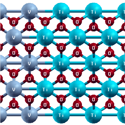Peeling away the electronic complexity of nanostructures
Heterostructures made from stacking thin films of different complex oxides can host a variety of exotic phases at the interfaces. Nature dislikes discontinuities in the physical properties across the boundary and often the result is redistribution of charge between layers—electronic “reconstruction”—or atomic reconstruction at the interface that smoothes out these sharp divisions.
Reconstruction does not always dictate the properties, however. In a paper published in Physical Review Letters, Victor Pardo of the Department of Physics at UC Davis and Universidade de Santiago de Compostela in Spain, and Warren Pickett of the Department of Physics at UC Davis, study the evolution of the properties of alternating layers of and using first-principles density functional calculations. They find a strong dependence of the electronic properties on the thickness of the layer. In particular, for a multilayer consisting of three layers ( ) of sandwiched between five layers ( ) of , they predict an essentially two-dimensional electronic state where the valence and conduction bands cross at a single point at the Fermi level.
The researchers find that, in contrast to typical materials, the electronic states exhibit linear dispersion in one direction, and quadratic in the perpendicular direction. Another way to think about this is to consider a strongly direction-dependent effective mass. They show that the effect is due to the small thickness of the layers—a quantum confinement effect—and not due to charge redistribution. Their calculations explicitly show that addition of layers replaces the single point at the Fermi level by a surface. – Alex Klironomos





